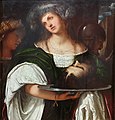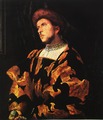Girolamo Romanino

Girolamo da Romano , known as Il Romanino (also romanino , Girolamo Romani , Girolamo Brescia , Jerome de Brescia , Jerome Rumani Brixianus ; * is between 1484 and 1487 in Brescia, † after 1562 ibid) one was Italian painter and fresco painter of the High Renaissance from school to Brescia.
Life
He was the son of Giovanni Battista da Romano, called "Romanino". Girolamo had two brothers, Antonio and Alessandro (* 1490), who were also painters. According to a census, he was 33 years old in 1517 and lived with his mother and a 10-year-old nephew and two servants. In 1534 he had a seven-year-old son Bonaventura, whose mother is unknown. In 1548, the 63-year-old Romanino was married to a 32-year-old Paola with whom he had four children: fourteen-year-old Giulia and the younger Carlo, Giacomo and Margherita.

More details about his education are not known, occasionally it has been suggested that he was a student of Floriano Ferramola . A stay in Venice is very likely, where he came under the influence of Giorgione . His earliest known work is the Descent from the Cross for the Church of San Lorenzo in Brescia, which is now in the Gallerie dell 'Accademia in Venice, and which he signed and dated “ Hieronymi Rumani Brixiani opus 1510 dicembris ”.
In his youth he was friends with Altobello Melone , with whom he shared an interest in Northern European art. In 1513 Romanino created the altar of Santa Giustina in Padua (today: Museo civico, Padua) and in 1516–17 the altar for the Church of San Francesco in Brescia; he also decorated the entire choir of San Francesco with frescoes , which, however, were no longer preserved by the end of the 19th century.
In the cathedral of Cremona , he created frescoes on the theme of the Passion of Christ in 1519-20 , where he showed an ability to represent genre close to the people and also echoes of Dürer . However, he was subsequently replaced by Pordenone .
From 1521 to 1524 he worked with Moretto on the painting of the Sacrament Chapel of San Giovanni Evangelista in Brescia. Shortly afterwards he painted the organ wings in Asola Cathedral (1524-25), where he also decorated the pulpit from 1536-37 .
The polyptych by Sant'Alessandro , now in the National Gallery in London , was made in 1525. In 1529 he signed an altarpiece with St. Anthony of Padua for the Church of San Bernardino in Salò .

In addition to Dosso Dossi and Marcello Fogolino, Romanino worked in the Castello del Buonconsiglio in Trento from 1531–32 on a cycle of mythological frescoes, which is one of his main works. He created further frescoes in 1534 in the church of Santa Maria della Neve in Pisogne . Romanino also left several works in Valcamonica .
From 1539 to 1541 he painted the pictures for the organ wings in the Duomo Vecchio of Brescia, and his paintings for the organ of San Giorgio in Verona were also highly praised .
His late works include the Mannalese (after 1550) in the Duomo Vecchio in Brescia and the Sermon on the Mount (1557) in the Church of San Pietro in Modena .
In October 1559 he was elected to the Brescia City Council. Romanino's pupils included his son-in-law and colleague Lattanzio Gambara , who was married to Romanino's daughter Margherita. Other students of Romanino were Girolamo Muziano and Callisto da Lodi .
The exact time of his death is not yet known.
Appreciation
Girolamo Romanino, along with Savoldo and Moretto da Brescia, is one of the three most important masters of the Veneto - Lombard school of Brescia. It shows a clear influence from Giorgione , from whom he took over the sfumato and the soft coloring, and also from the young Titian . Other influences sees the criticism in Lorenzo Lotto and in Milan make Bramantino , as well as in Dürer . His “anti-classical” tendency towards the narrative and folklore, which can be found particularly in his significant frescoes, most of which are unfortunately not well preserved, is regarded as typically Lombard.
In later works, his coloring shows a silvery tone that he apparently adopted from his younger colleague Moretto.
Restitution of Cristo Portacroce , 2012

Romanino's masterpiece Christ with the Cross (“ Cristo portacroce ”) went through the world press in 2012.
The picture corresponds to a type of picture known in Renaissance Italy, in which Jesus is depicted with the cross on his shoulder and with a crown of thorns on the way to Golgotha . Giorgione, Tizian and Lotto also created similar representations . It is a private devotional picture, so the depiction is very intimate and focuses almost exclusively on the suffering Jesus shown in half- length figure, who here is painted by Romanino in a shiny silk robe of delicate salmon rose. To the left of the cross you can see the face of a scornful mocker .
The owner of this exquisite painting was the Jewish art collector Federico Gentili di Giuseppe, who died in 1940 and who lived in Paris . His family had to flee from persecution by the Nazis in World War II and was expropriated. The valuable collection of 70 paintings was auctioned against the will of the family in 1942 under the Vichy regime .
The Romanino painting was acquired in 1998 by the Pinacoteca di Brera in Milan; its prehistory and origin from the Gentili di Giuseppe collection were known. Gentili's descendants tried in vain for twelve years to have the painting returned , but the Italian state refused to do so, citing Italian legislation.
When Brera sent the painting to America on loan for an exhibition in 2011 - to the Mary Brogan Museum of Art and Science in Tallahassee , Florida - attorney Corinne Hershkovitz took action, pointing out that it had been stolen and rightfully belonged to the descendants of Gentili di Giuseppe belonged. With the help of the US state, the picture was confiscated and then returned to the family.
Gentili's six heirs , including his grandson Lionel Salem, decided to auction the painting at Christie's in New York on June 6, 2012. It achieved a record price of 3,650,000 euros (4,562,500 US dollars ) - the highest sum ever paid for a picture by Romanino.
Picture gallery
Pietà , 1510, Accademia , Venice
Salomé with the head of John the Baptist , 1517, Gemäldegalerie , Berlin
Presentation of Jesus in the temple , 1529, Pinacoteca di Brera , Milan
Portrait of a young man , (from the Palazzo Fenaroli, Brescia) Szépművészeti Múzeum , Budapest
Pala di San Domenico ( Coronation of the Virgin Mary with St. Dominic and other saints ), ca.1545, Pinacoteca Tosio Martinengo , Brescia
Ecce Homo , Lower Saxony State Museum , Hanover
Christian I of Denmark visits Colleoni , detail of a fresco in the Castello di Malpaga
Flute Quartet , 1531–32, fresco in the loggia of the Castello del Buonconsiglio, Trento
Suicide of Cleopatra , 1531–32, fresco in the loggia of the Castello del Buonconsiglio, Trento
Works (selection)
- Madonna with Child and Saints and Pieta (Museum zu Berlin),
- Adoration of the Christ Child (London, National Gallery),
- Birth and Lamentation of Christ (in San Giuseppe in Brescia) and
- Assumption of Mary (Bergamo, Sant 'Alessandro).
literature
- Stefano Fenaroli: Romanino Girolamo , in: Dizionario degli artisti bresciani , S. Malaguzzi, 1877, pp. 201–216, as a Google book or in the internet archive (Italian, viewed May 23, 2020)
- Romanino (originally Girolamo Romani) , in: Lexikon der Kunst , Vol. 10, Karl Müller Verlag, Erlangen, 1994, p. 125
- Romanino, Girolamo , in: Meyers Konversationslexikon , vol. 13, Verlag des Bibliographisches Institut, Leipzig and Vienna, fourth edition, 1885–1892, p. 918, online in the retro library (viewed on May 22, 2020)
- Romanino, Girolamo da Romano detto il , in "Treccani" (Italian; seen on May 22, 2020)
Web links
- Works by Girolamo Romanino at Zeno.org .
Individual evidence
- ↑ Naomi Blumberg: Il Romanino , short biography in the Encyclopaedia Britannica online (English; viewed on May 22, 2020)
- ↑ a b Stefano Fenaroli: Romanino Girolamo , in: Dizionario degli artisti bresciani , S. Malaguzzi, 1877, pp. 201–216, here: p. 207, online in the Internet archive (Italian, viewed May 23, 2020)
- ↑ a b c d e f g h i j k l Romanino, Girolamo da Romano detto il , on the “Treccani” website (Italian; viewed on May 22, 2020)
- ↑ a b Stefano Fenaroli: Romanino Girolamo , in: Dizionario degli artisti bresciani , S. Malaguzzi, 1877, pp. 201–216, here: p. 202, online in the Internet archive (Italian, viewed May 23, 2020)
- ↑ a b c Stefano Fenaroli: Romanino Girolamo , in: Dizionario degli artisti bresciani , S. Malaguzzi, 1877, pp. 201–216, here: p. 203, online in the Internet archive (Italian, viewed May 23, 2020)
- ↑ a b c d Romanino (actually Girolamo Romani) , in: Lexikon der Kunst , Vol. 10, Karl Müller Verlag, Erlangen, 1994, p. 125
- ↑ Stefano Fenaroli: Romanino Girolamo , in: Dizionario degli artisti bresciani , S. Malaguzzi, 1877, pp. 201–216, here: p. 213, online in the Internet archive (Italian, viewed May 23, 2020)
- ↑ a b Stefano Fenaroli: Romanino Girolamo , in: Dizionario degli artisti bresciani , S. Malaguzzi, 1877, pp. 201–216, here: p. 210, online in the Internet archive (Italian, viewed May 23, 2020)
- ↑ Stefano Fenaroli: Romanino Girolamo , in: Dizionario degli artisti bresciani , S. Malaguzzi, 1877, pp. 201–216, here: pp. 205-6 and 212, online in the Internet archive (Italian, viewed May 23, 2020 )
- ↑ Stefano Fenaroli: Romanino Girolamo , in: Dizionario degli artisti bresciani , S. Malaguzzi, 1877, pp. 201–216, here: p. 211, online in the Internet archive (Italian, viewed May 23, 2020)
- ↑ a b Stefano Fenaroli: Romanino Girolamo , in: Dizionario degli artisti bresciani , S. Malaguzzi, 1877, pp. 201–216, here: p. 215, online in the Internet archive (Italian, viewed May 23, 2020)
- ↑ a b Girolamo Romanino , short biography on the website of the National Gallery , London (English; viewed May 22, 2020)
- ↑ Romanino, Girolamo , in: Meyers Konversationslexikon , Vol. 13, Verlag des Bibliographisches Institut, Leipzig and Vienna, Fourth Edition, 1885–1892, p. 918, online in the retro library (viewed on May 22, 2020)
- ↑ a b c d e Didier Rykner: Restitution by "Christ carrying the Cross" by Romanino , article from February 13, 2012, online at: The Art Tribune (English, French; viewed May 22, 2020)
- ↑ a b Ian Johnston: 474-year-old painting stolen by Nazis given to owner's heirs , online at: Msnbc. com (accessed May 22, 2020)
- ↑ Italian masterpiece looted by Nazis returns to Jewish heirs , article from April 19, 2012, in The Times of Israel (English; viewed May 22, 2020)
- ↑ Paul Jeromack: Looted by Nazis, a Romanino is returned , article online on artnet ( undated ; English; seen on May 22, 2020)
- ↑ Eliottingotham: Masterpiece by Girolamo Romanino achieves $ 4,562,500 at Christie's , article from June 17, 2012, online at: wordpress.com (English; seen May 22, 2020)
- ↑ Doriane Lacroix Tsarantanis: Le tableau de Girolamo Romanino, finalement restitué à ses propriétaires légitimes, atteint un prix record chez Christie's , article from June 12, 2012, online in Le Journal des Arts (French; viewed May 22, 2020)
| personal data | |
|---|---|
| SURNAME | Romanino, Girolamo |
| BRIEF DESCRIPTION | Italian painter |
| DATE OF BIRTH | around 1485 |
| PLACE OF BIRTH | Brescia |
| DATE OF DEATH | after 1562 |
| Place of death | Brescia |








